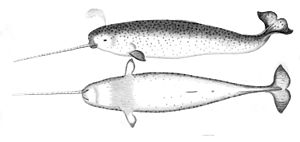Narhval
| Narhval | |
|---|---|
 Narhval | |
| Bevaringsstatus | |
 Næsten truet (IUCN 3.1) | |
| Videnskabelig klassifikation | |
| Rige | Animalia (Dyr) |
| Række | Chordata (Chordater) |
| Klasse | Mammalia (Pattedyr) |
| Orden | Cetacea (Hvaler) |
| Familie | Monodontidae (Monodontidae) |
| Slægt | Monodon |
| Art | monoceros |
| Videnskabeligt artsnavn | |
| Monodon monoceros Linnaeus 1758 | |
| Kort | |
 Narhvalens udbredelse. | |
| Hjælp til læsning af taksobokse | |
Narhvalen (norrønt; náhvalr, lighval[1]), Monodon monoceros, er et dyr i ordenen af hvaler og er sammen med hvidhvalen de eneste medlemmer af familien Monodontidae. Den voksne narhval måler 3,8-5 m og vejer 800-1600 kg. Den har ingen rygfinne. Narhvalhanner har en enkelt lang snoet stødtand, i sjældne tilfælde 2. I sjældne tilfælde kan også hunner have en enkelt stødtand, der dog er væsentlig kortere end hannens. Hannerne bruger stødtænderne i rituelle kampe om hunnerne.
Narhvalens hud (mattak) er meget eftertragtet blandt inuit og er en vigtig kilde til C-vitamin for befolkningen i Arktis.
I middelalderen blev narhvalens stødtand solgt som enhjørningehorn i Europa.
Kilder
- ^ Politikens Nudansk Ordbog, L-Å: "Náhvalr" af "nár": et lig og "hvalr": hval. Navnet skyldes at dyret er sort- og hvidplettet og kan minde om lig af druknede; fra dansk optaget i engelsk, tysk, fransk.
| Søsterprojekter med yderligere information: |
|
Medier brugt på denne side
Forfatter/Opretter: Sansculotte, Licens: CC BY-SA 2.5
Verbreitung des Narwals.
Narwhal distribution map
Solid: Regular occurrence of Narwhal
Striped: Incidental occurrence of Narwhal'Male Narwhal or Unicorn. Greenland Shark.' (Monodon monoceros)
Forfatter/Opretter: soebe, Licens: CC-BY-SA-3.0
Narwhal (Monodon monoceros) skull with two tusks, as seen in the Zoological Museum in Hamburg, Germany; photographed in September of 2004 by Sönke Behrends. The picture was taken in the Zoological Museum in Hamburg. The object is behind protective glas, which causes some reflections. Flash was switched off for that matter. The worst reflections were edited. The skull was brought to Hamburg in 1684, and provably originates from a female animal. The German description provided by the museum translates to:
“The right tooth can also grow into a tusk in very rare cases, as proven by 12 skulls collected by various museums during the past 300 years.
These skulls show, that the second tooth can be developed to a very different degree, and even -- unexpectedly -- the spiralling direction of growth is towards the left and not towards the right mirroring the other half.
All these skulls with two tusks originate from male animals; however, the skull in Hamburg is provably that of a female. It is thus unique.”
Forfatter/Opretter:
- Status_iucn3.1_NT.svg: Peter Halasz
- derivative work: Jeffrey Lins
Danish version of system image for conservation status



